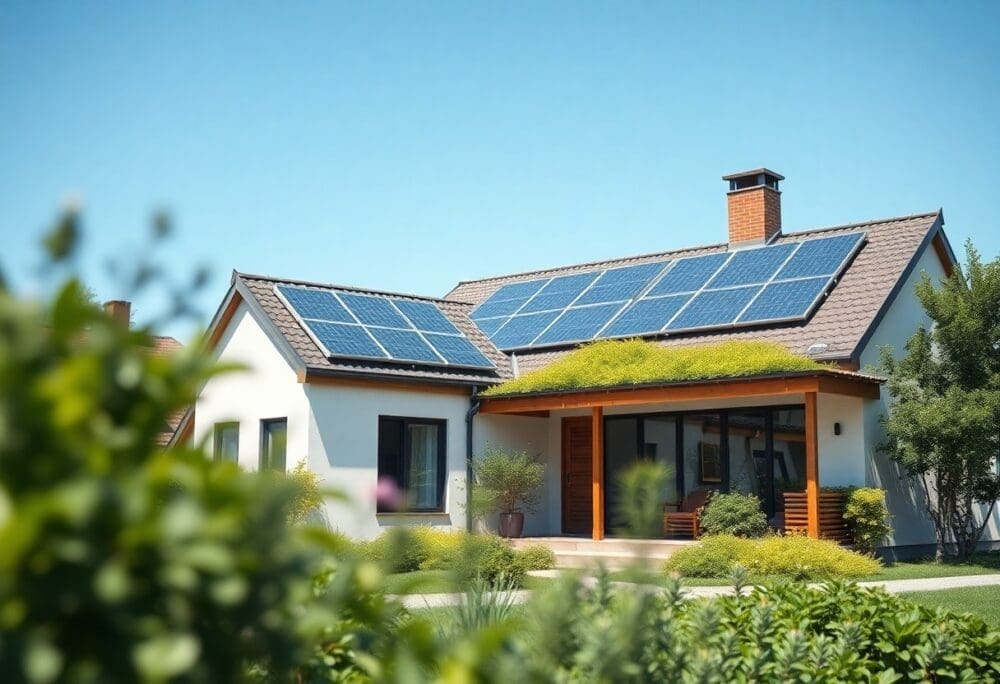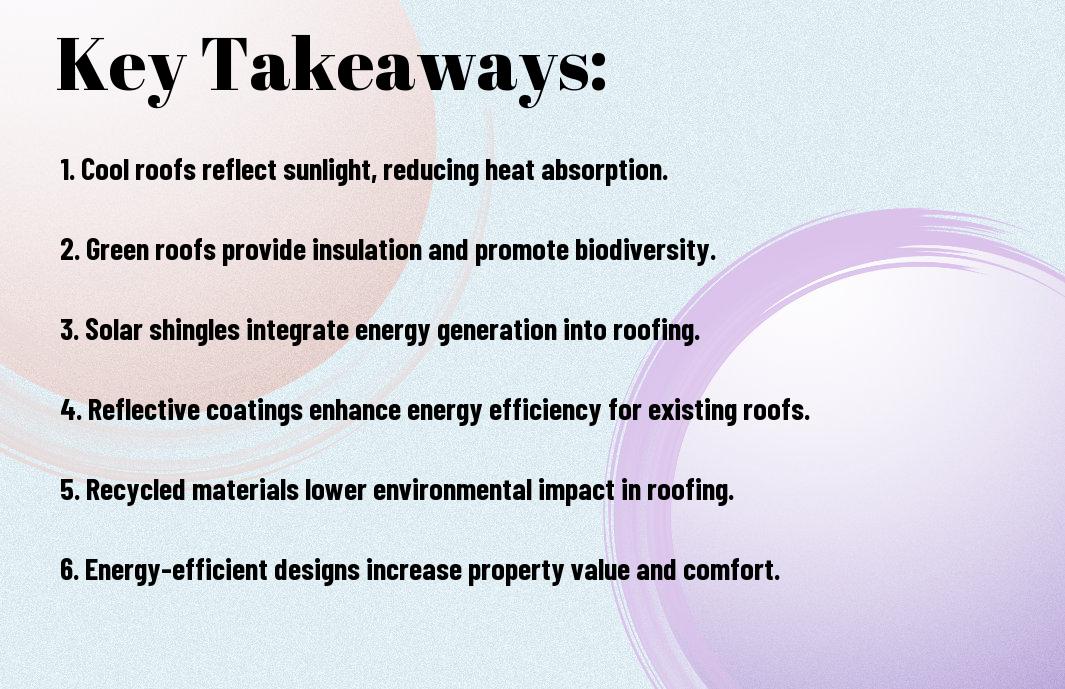There’s a growing emphasis on energy-efficient roofing solutions as you seek ways to reduce your carbon footprint and lower energy bills. By adopting modern roofing materials and technologies, you can significantly enhance your home’s sustainability. From reflective coatings to green roofs, these innovations not only improve energy efficiency but also contribute to a healthier environment. In this blog post, you’ll discover the latest trends in energy-efficient roofing that can elevate your living space while promoting sustainable practices.
Key Takeaways:
- Cool roofing materials reflect more sunlight and absorb less heat, leading to reduced energy consumption for cooling systems in hot climates.
- Green roofs, which incorporate vegetation, provide natural insulation, improve air quality, and help manage stormwater runoff, contributing to sustainable urban environments.
- Advanced insulation technologies in roofing systems enhance energy efficiency, keeping homes warmer in the winter and cooler in the summer, thereby lowering energy bills.
Benefits of Energy-Efficient Roofing
While energy-efficient roofing offers numerous advantages for homeowners, the most notable benefit is the substantial reduction in energy consumption. By optimizing your roof’s insulation and reflectivity, you can maintain a more stable indoor temperature, which ultimately leads to lower energy bills. Additionally, these roofing systems enhance the longevity of your roof, requiring fewer repairs and replacements over time, making it a smart investment for sustainable living.
Cost Savings
Before considering your roofing options, it’s important to evaluate the potential cost savings associated with energy-efficient materials. By investing in a roof designed to minimize energy loss, you can significantly cut down on heating and cooling expenses. Over time, these savings can offset the initial expenses of installation, providing not only financial relief but also enhancing your home’s value.
Environmental Impact
Before making a decision about your roofing, it’s important to understand the environmental benefits. Energy-efficient roofing materials often use sustainable resources and reduce greenhouse gas emissions by lowering energy consumption in your home. By choosing such options, you contribute to a healthier planet while enhancing your living environment.
This choice helps minimize the demand for non-renewable energy sources and promotes overall conservation efforts. Implementing energy-efficient roofing can significantly reduce your carbon footprint and lessen the strain on your local power grid. As more homeowners adopt these practices, the collective positive impact on the environment becomes increasingly significant, paving the way for a more sustainable future.
Types of Energy-Efficient Roofing Materials
Now that you are aware of the significance of energy-efficient roofing, let’s explore the various materials available. Choosing the right roofing can yield substantial energy savings. Here’s a breakdown of popular energy-efficient roofing materials:
| Material | Benefits |
| Metal | Durable, reflective, and recyclable |
| Slate | Long-lasting, insulation properties |
| Clay tiles | Natural, excellent ventilation and thermal performance |
| Rubber | Flexibility, eco-friendly, and weather-resistant |
| Shingles | Variety of styles and energy-efficient options |
Assume that opting for one of these materials, carefully selected based on your climate and home design, can greatly enhance your home’s energy efficiency.
Cool Roofs
Among the innovative solutions in roofing is the concept of cool roofs. These roofs are designed to reflect more sunlight and absorb less heat than traditional roofs. You can significantly reduce your home’s temperature, leading to decreased energy costs by using reflective materials, such as coatings or specially designed shingles that absorb less solar energy.
Green Roofs
Roofs covered with vegetation, often referred to as green roofs, provide numerous environmental benefits. You can effectively reduce urban heat islands, improve air quality, and enhance your building’s insulation by incorporating a layer of soil and plants onto your rooftop.
In addition to these benefits, green roofs promote biodiversity by providing habitats for various species. They also manage stormwater, reducing runoff and alleviating the burden on drainage systems. Lastly, they can create a unique outdoor space, allowing you to enjoy nature right at home while benefiting from energy efficiency and environmental sustainability.
Innovative Roofing Technologies
Despite traditional roofing materials dominating the market, innovative technologies are transforming the way you think about roofing systems. Modern advancements prioritize energy efficiency, turning your roof into an asset that actively contributes to sustainability. These technologies not only minimize your environmental footprint but also can lead to significant savings on energy costs over time.
Solar Roofing
Roofing systems that integrate solar technology, such as solar shingles, allow you to harness renewable energy directly from your home. These sleek designs blend seamlessly with your existing roofing, providing a sustainable energy source that can dramatically lower your utility bills. Investing in solar roofing is not just a step towards reducing your carbon footprint; it positions you ahead in the sustainable living movement.
Reflective Coatings
Among the latest advancements in roofing technology, reflective coatings are designed to minimize heat absorption in your home. By reflecting sunlight away, these coatings help maintain a cooler interior temperature, reducing the need for extensive air conditioning during hot months. This energy-efficient option extends the life of your roof while significantly impacting your energy consumption.
In fact, using reflective coatings can lower your roof’s surface temperature by up to 20 degrees Fahrenheit, resulting in substantial energy savings. These coatings not only enhance your roof’s durability by preventing thermal cracking and degradation but also contribute to a more comfortable living environment. By applying reflective coatings, you’re making a cost-effective decision that benefits both your wallet and the planet.
Government Incentives and Rebates
Not only does investing in energy-efficient roofing enhance your home’s sustainability, but it can also lead to financial savings through various governmental incentives and rebates. Many programs are designed to encourage property owners like you to adopt greener solutions, thereby reducing environmental impact and promoting energy efficiency. By taking advantage of these financial benefits, you can make informed decisions that align with your eco-conscious lifestyle while also supporting regional sustainability goals.
Federal Programs
Programs at the federal level offer tax credits and financial assistance that can ease the burden of upgrading to energy-efficient roofing. Initiatives like the Residential Energy Efficiency Tax Credit provide tangible savings for homeowners who implement sustainable improvements, allowing you to invest in roofing materials that reflect sunlight and improve insulation. By participating in these federally backed programs, you position yourself to save both money and energy long term.
State and Local Initiatives
Government initiatives at state and local levels also play a significant role in promoting energy efficiency. These often include grants, rebates, and property tax exemptions that target sustainable home improvements, such as energy-efficient roofing. Familiarizing yourself with your local offerings can unlock substantial savings, making it more accessible for you to invest in a greener living environment.
Consequently, local municipalities and state governments frequently collaborate with utility companies to provide tailored incentives for adopting energy-efficient practices. These initiatives may include cash rebates for specific energy-efficient roofing products, as well as low-interest loans to facilitate installations. By taking the time to research and utilize these resources, you can maximize your financial savings while contributing to a healthier planet. Stay connected with local energy-saving programs, as they often evolve, ensuring that you can continue to benefit from available opportunities.
Choosing the Right Roofing Solution
All roofing materials and systems are not created equal—selecting the appropriate option for your home is crucial for maximizing energy efficiency. You should consider your local climate, the design of your home, and your specific energy goals. With the right choice, you can significantly reduce your energy consumption, enhance comfort, and promote sustainable living while ensuring long-term value in your investment.
Assessing Home Climate
One of the first steps in selecting an energy-efficient roofing solution is to evaluate the climate conditions in your area. Understanding temperature fluctuations, humidity levels, and local weather patterns can help you make an informed decision about which roofing material will perform best for your home.
Material Durability
An important factor in your roofing decision is the durability of the materials you choose. Selecting long-lasting materials can save you money on replacements and repairs while enhancing your home’s energy efficiency. Energy-efficient roofing options are designed to withstand various weather conditions, providing insulation and preventing heat loss.
For instance, materials like metal and tiles offer robust durability, often lasting decades, while also reflecting heat away from your home. Selecting such materials can help maintain a stable indoor temperature, reducing your reliance on heating and cooling systems. Investing in durable roofing solutions not only protects your home but also contributes to a sustainable lifestyle by minimizing waste from frequent replacements.
Maintenance for Energy Efficiency
After investing in energy-efficient roofing, it’s crucial to focus on regular maintenance to ensure optimal performance. Routine upkeep helps preserve the roof’s integrity, reducing energy costs and extending its lifespan. By proactively addressing any issues, you can maintain a comfortable indoor climate while maximizing the benefits of your energy-efficient roofing system.
Regular Inspections
Maintenance should begin with regular inspections of your roof. You want to check for any signs of wear or damage, especially after severe weather events. Identifying potential problems early can effectively prevent larger issues, ultimately contributing to better energy efficiency and lower utility bills.
Cleaning and Repairs
Above all, keeping your roof clean and promptly addressing necessary repairs can significantly impact its energy efficiency. Accumulation of debris or damage from weather can impede performance, making your roof less effective in its energy-saving capacity.
Further, when you clean your roof, ensure you remove leaves, moss, and other debris that can trap moisture and cause damage. Simple repairs, like sealing cracks or replacing missing shingles, prevent heat loss and maintain your roof’s energy-efficient properties. By prioritizing these actions, you promote longevity and enhance the efficiency of your entire roofing system.
Conclusion
Ultimately, adopting energy-efficient roofing trends is crucial for enhancing your home’s sustainability and reducing energy costs. By considering innovative materials, reflective surfaces, and green technologies, you not only improve your property’s efficiency but also contribute positively to the environment. Keeping up with these trends empowers you to make informed decisions that benefit both your home and the planet, ensuring a healthier future for generations to come.
Q: What are the benefits of energy-efficient roofing for homeowners?
A: Energy-efficient roofing offers several advantages for homeowners, including reduced energy costs, increased home comfort, and lower environmental impact. By utilizing materials that reflect sunlight and minimize heat absorption, these roofs help regulate indoor temperatures, leading to decreased reliance on air conditioning and heating systems. This can significantly lower utility bills. Additionally, many energy-efficient roofing options are made from sustainable materials, contributing to environmentally friendly construction practices and promoting a healthier living space.
Q: What materials are commonly used in energy-efficient roofing systems?
A: Several materials are recognized for their energy-efficient properties. Cool roofing materials, such as reflective shingles and tiles, are designed to reflect more sunlight and absorb less heat. Metal roofing is also popular due to its longevity and excellent reflective qualities. Additionally, green roofs, which incorporate vegetation, not only provide insulation but also improve air quality. Other materials such as slate, clay, and certain types of asphalt shingles are also being engineered to offer enhanced energy efficiency through improved reflectivity and insulation.
Q: How can homeowners assess whether their existing roof is energy-efficient?
A: Homeowners can evaluate their roof’s energy efficiency by considering factors such as the type of roofing material, age, and insulation quality. One can also check for the Energy Star label, which indicates that the material meets specific energy-efficiency standards. Additionally, homeowners can conduct a simple test by monitoring indoor temperature fluctuations during hot and cold months; significant variations may indicate that the roof is not effectively regulating heat. Consulting with a roofing professional can also provide insights into potential upgrades or improvements for enhancing energy efficiency.






